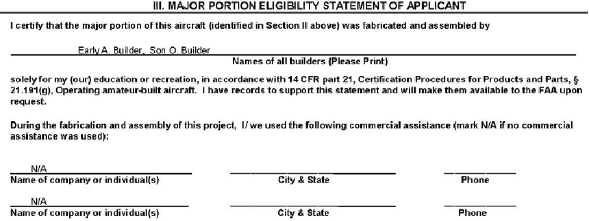FAA 51% Rule
51% or Major Portion Rule for Experimental-Amateur Built Aircraft
The builder of an aircraft is the person who builds the major portion of the aircraft. When you build 51% of the parts and do 51% of the assembly of the total, you have done the major portion. The FAA calls this the Major Portion Rule. In order for the aircraft to be certified under the favorable Experimental Amateur-Built category, the 51% builder must be an amateur (e.g., building the aircraft for education or recreation per FAR 21.191[g]). The FAA maintains a list of kits that the FAA has determined that the kit manufacturer has completed a maximum of 49%. Being on the approved kit list helps the inspector quickly determine if you have built the major portion. Just because a kit isn’t yet on the list does not automatically mean it doesn’t meet the major portion rule, it may be that the kit manufacturer has not yet had the FAA look at their kit.
An aircraft built from a kit may be eligible for amateur-built certification, provided the major portion has been fabricated and assembled by the amateur builder. A certain quantity of complex parts made from sheet metal, fiberglass, or polystyrene would also be acceptable, provided the kit still meets the major portion of the fabrication and assembly requirement, and the amateur builder satisfies the FAA inspector or DAR that completion of the aircraft kit was not merely an assembly operation.
AC 20-27G, item 7b:
“A determination of major portion will be made by evaluating the amount of work accomplished by the amateur builder(s) against the total amount of work necessary to complete the aircraft, excluding standard procured items.
Note: The major portion of the aircraft is defined as more than 50 percent of the fabrication and assembly tasks, commonly referred to as the “51-percent rule.” For example, an amateur-built kit found on the FAA List of Amateur-Built Aircraft Kits has 40 percent of the fabrication/assembly completed by the kit manufacturer. In order to be eligible for an experimental amateur-built airworthiness certificate and per the major portion rule, the fabrication and assembly tasks that may be contracted out (for hire) to another individual (or builder/commercial assistance center) needs to be less than 10 percent.”
AC 20-27G, Appendix 12:
A notarized FAA Form 8130-12, Eligibility Statement - Amateur-Built Aircraft:
What if I buy a project under construction?
If a second (or more) owner(s)/builder(s) takes over the project, as long as all builders are amateurs, building for their own education or recreation, the aircraft can still be certified in the experimental amateur-built category. If a group of amateur builders construct an aircraft as a group project, the same is true.
The undisputed evidence of the builder’s work is the builder’s log, photos and a bill of sale.
CAUTION: When buying a project, if the seller does not have a builder’s log and necessary documentation to be sold with the project, do not buy the project. Such documentation is required to prove the aircraft was amateur-built and receive an experimental amateur-built airworthiness certificate. If there were 10 builders, get all logs, photos and bills of sale from each!
If I buy a project, will I be able to obtain a Repairman's Certificate?
AC 20-27G, Item 17:
REPAIRMAN CERTIFICATION. The aircraft builder may be certificated as a repairman if the builder is the primary builder of the aircraft “and can satisfactorily prove to us that you can determine whether the aircraft is in a condition for safe operation." Fill out FAA Form 8610-2 with the FAA Inspector or DAR during the final aircraft inspection to qualify.

